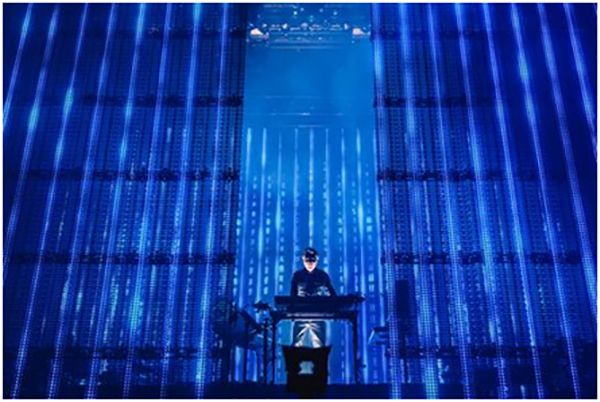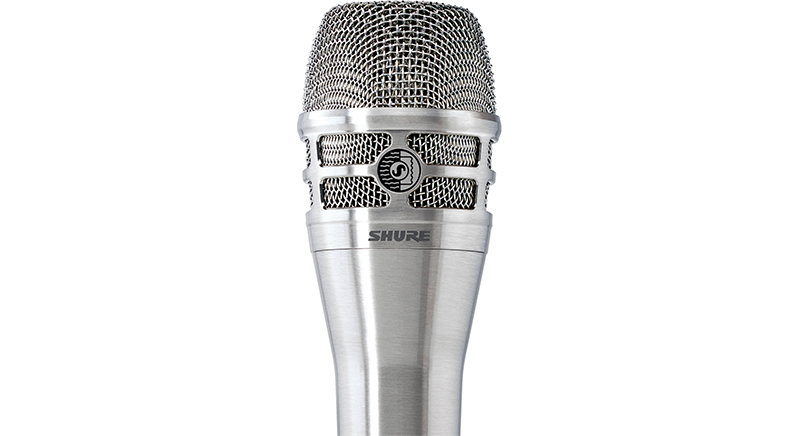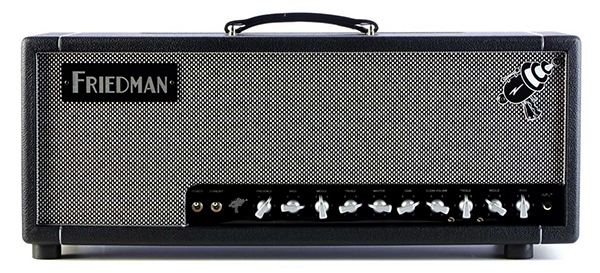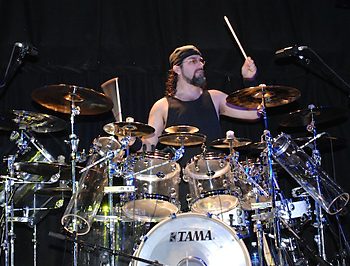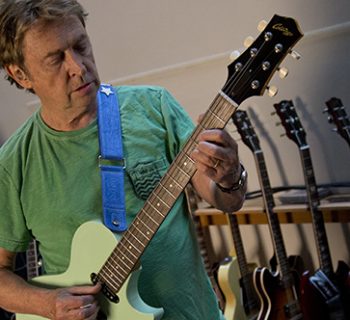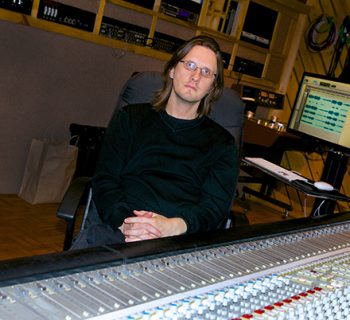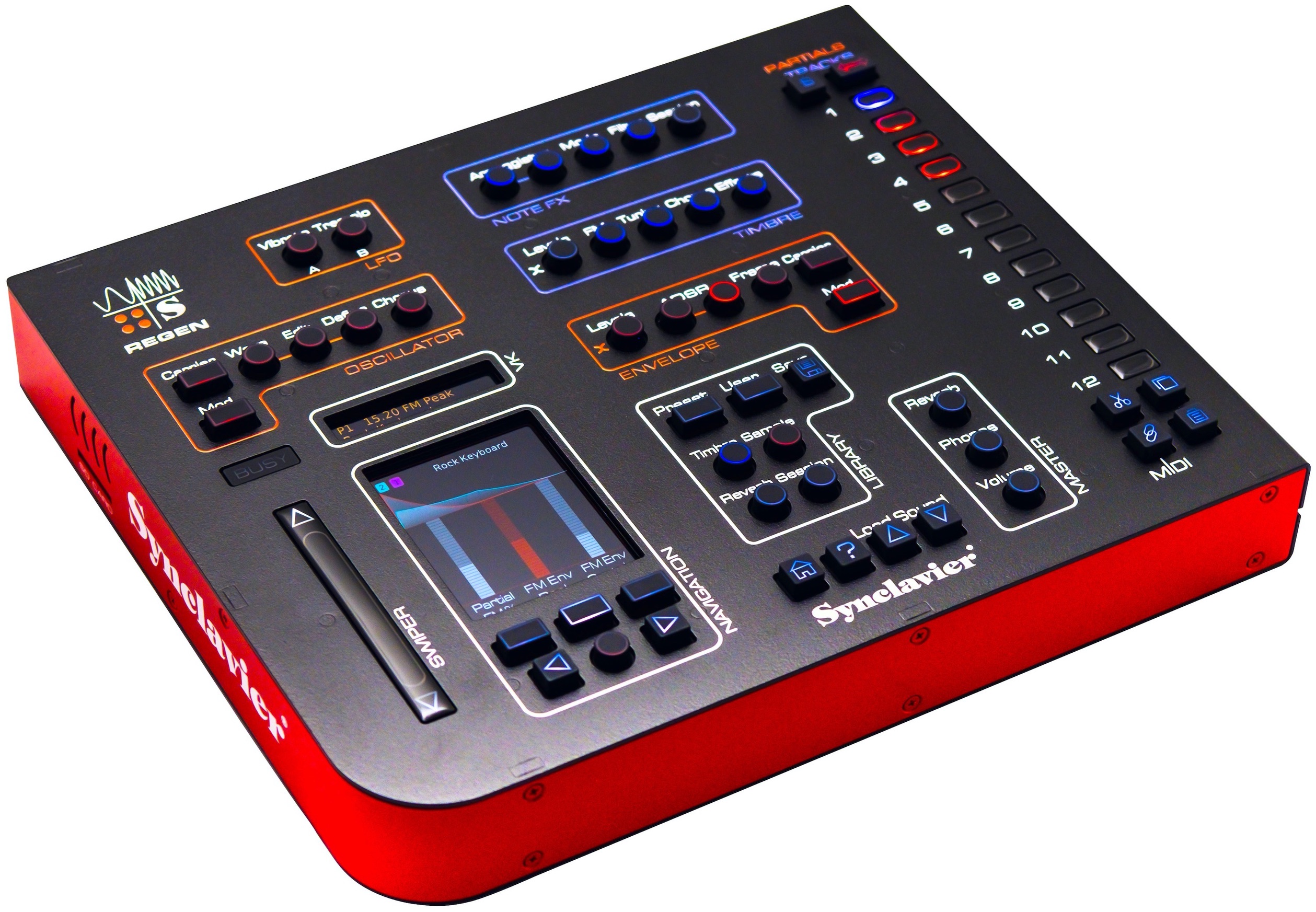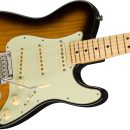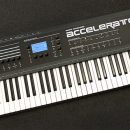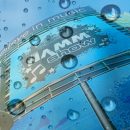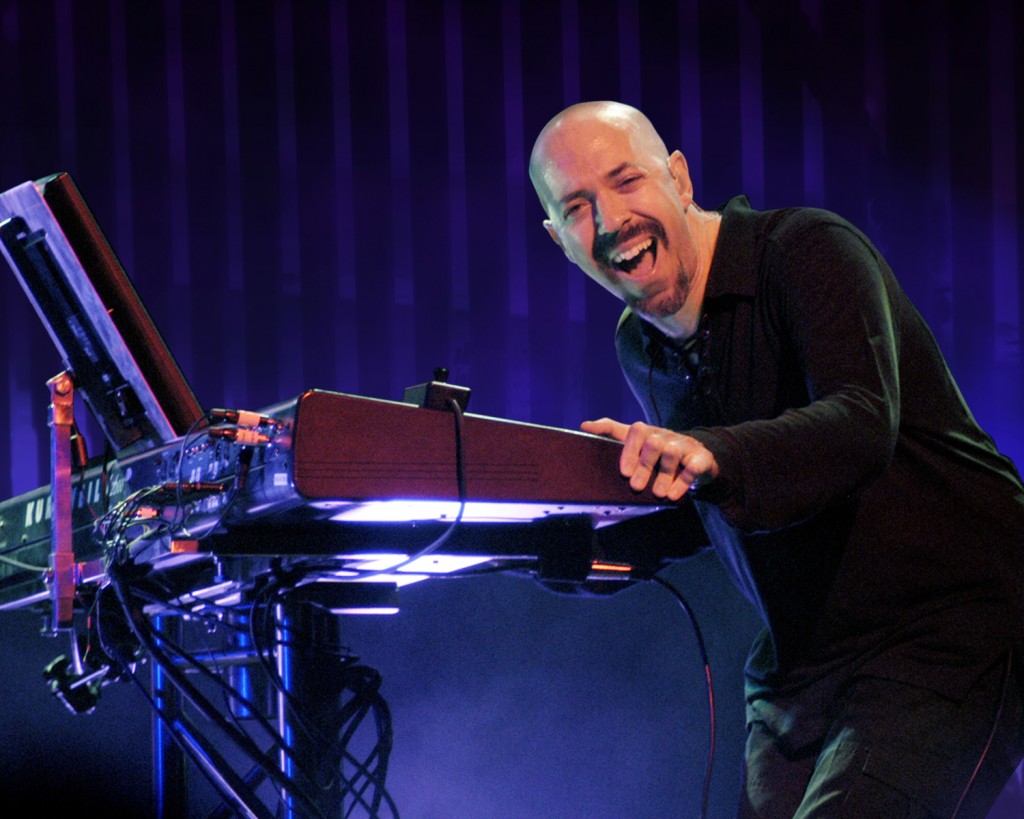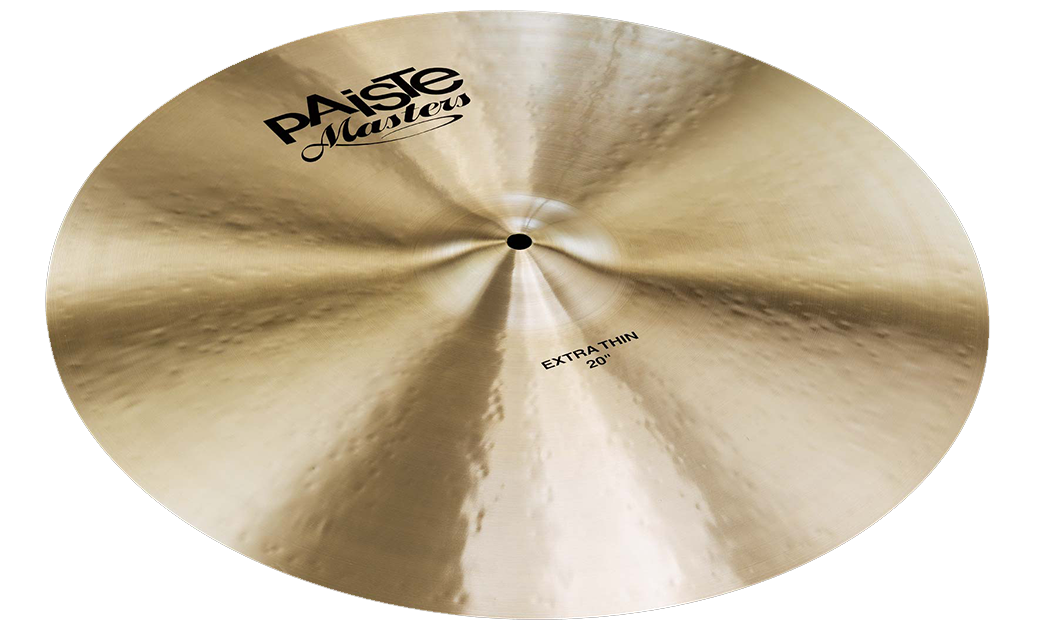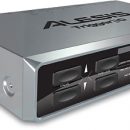I wanted to go into a more electro type of mood in terms of beat and sequences.
French musician Jean-Michel Jarre is universally hailed as the godfather of electronic music, having pioneered the use of synthesizers in popular music. Beginning his career at the end of the ‘60s, Jarre has sold in excess of 80 million records to date, and his performances are truly the stuff of legend—or Guinness Book world records. His concert event celebrating Moscow, Russia’s 850th birthday had 3.5 million people in attendance. That is not a typo. He has held the world record for concert attendance repeatedly, having performed at least five major concert spectacles with 1 million or more people in attendance at each. What makes his shows this special? Incredible visual light shows that accompany his dreamy, melodic music that crosses and blurs the boundaries of pop, electronica, ambient, and fusion.
If there’s one keyboard player that every other major keyboard player can admit to listening to at some point over the years, it is Jean-Michel Jarre. Without him, it’s quite possible that the new wave movement, progressive rock, and virtually all music from the ‘80s might have never existed! So it was with great excitement that Jarre undertook his latest two-album project: Electronica Volume I: The Time Machine, and Electronica Volume 2: The Heard of Noise, on which he collaborated with well-known electronic musicians from across the world.

This was not merely the stuff of musicians shipping files back and forth across the Internet. Jarre truly collaborated with each artist, travelling the world to work in each artist’s studio. The results are a sonic tapestry of electronic music, and on which you can truly hear the collaborative results of each artist meshing their sound and style with Jean-Michel Jarre, whose music has a swirling, swishing, pulsating, and percolating signature that is uniquely its own.
Collaborators on Volume 1: Gesaffelstein, Little Boots, 3D of Massive Attack, Moby, Tangerine Dream, John Carpenter, M83, Boys Noize, Armin van Buuren, Pete Townsend, Vince Clarke, Air, Fuck Buttons, and Laurie Anderson.
Collaborators on Volume 2: Rone, Pet Shop Boys, Primal Scream, E.S., Julia Holter, Gary Numan, Jeff Mills, Peaches, Siriusmo, Yello, The Orb, Sebastien Tellier, Hans Zimmer, Cyndi Lauper, Christoph, and, if you can believe it, Edward Snowden (who speaks about the perils of ubiquitous surveillance).
Electronica Volume 1 Trailer: Video courtesy of Jean-Michel Jarre
MPc: Your music has been described as everything from electronica to new age to jazz fusion to EDM.
JMJ: To tell you the truth, I don’t like the word “new age.” I like the word “fusion,” for lots of different reasons I can explain. I mean, new age, it is purely an American label that has been done to basically all that is not dance floor electronic music. And it’s gathering lots of different style of music or musicians because you could say that lots of classical music could be approached with, kind of, new age parameters. It always felt a bit strange, this kind of label.
And fusion is actually not what I wanted to achieve with Electronica. Fusion is actually like blending styles. And the idea of Electronica is more like staying the creative process and trying to create, merging DNA, then collaborating with people—I mean, belonging to the same kind of… organic approach to sounds. For me, fusion is… when I say I don’t like the word, obviously it’s not the category, because when you have jazz fusion, like for instance mixing jazz with Brazilian music and things like that, it’s not at all what I had in mind with Electronica, it was more the kind of sharing process into the creative moment.
And when you’re saying about, when you are talking about the Pet Shop Boys or Gary Numan, I never considered them as pop artists, even though they’d done some pop. But more, for me they’re more symbolizing this era where British pop and rock was actually meeting and electronic music for the first time. And when you think about the Pet Shop Boys what I really like is this kind of club feel, quite happy club feel, mixed with a kind of rather melancholic type of texture. instantly recognizable vocal texture, but also the way they are blending tracks one to each other.
He had to fix some of the modulars every time, before every concert and also using hair dryers and things, to make the components at the right temperature.
And for Gary Numan, [he is] much more than a pop artist. He is one of the rare artists who, from the U.K. electro-pop scene, having with success created an entire world. Not only from an audio point of view, but also in a visual point of view. And the performance of… Gary Numan as a performer was exactly in sync with, is in exact sync with his vocal, kind of replicant from Blade Runner or kind of techno alien hero, coming from a Philip Dick novel. And his music is conveying this. And this kind of sci-fi vision that the ‘80s brought at one moment.
So it was really—you know, for Electronica 1 and 2, actually, for every artist, I had a very specific reason to work with these artists. Because for me it was people who have been very important to me as a source of inspiration.
And for Primal Scream, Primal Scream is actually a very interesting indie band mixing kind of garage sound with electronic sound. And one track I have been really impressed by is “Come Together.” And the idea, working and collaborating with them, was also working in a different approach by using sampling because, as we know, the sampling technique is part of electronic music composition and creation. That we had got the idea to start a collaboration through a sample from “Come Together,” but making, doing it in a total different direction.
Actually, when we did this track, it was during 2015 and we’ve been, Bobby Gillespie and myself, obviously, we’ve been very shocked by what happened in Paris and the terrorist acts. I mean, what happened at the Bataclan [theater] and all these horrible terrorist acts where actually music has been assassinated, as well also, because it was attacking the young generation of music lovers and also music itself. And this idea of together as one, which was approached in a rather psychedelic-acid way in the original. We said, it could be fun to get a kind of positive electro-pop anthem. But that’s what “As One” is all about in Electronica. It’s something which comes from the festival feel and being much more lighter because we need—we saw at that time we needed to express that, probably.
MPc: When you collaborated with all of these artists, one of the amazing things about it was that you didn’t just ship files back and forth like so many people do these days, but you actually went out and got together with everyone. Why don’t you tell me a little bit about that whole experience?
JMJ: Yeah, it’s a very interesting question, because we know that these days it’s almost banal and a cliché to have [featured guest] albums, where most of the time you are sending files with the Internet to people you will never meet and you will never talk to.
I had two principles for this project. One was actually, I would say visiting people and traveling with people, to meet people in person. And to share the creative process face-to-face in the same place. Because that is changing everything, obviously. And merge, as I was saying, merging our DNAs in the lines.
And the second one was to, actually for every collaborator, before even we meet, to write a piece of music, a demo, in the function of the phantasm, or the fantasy I had regarding the artist, but obviously leaving enough space for him or her to add whatever they wanted.
MPc: You did a pretty remarkable job in the context of capturing the vibe of a lot of these artists in the songs that you created as a template for each of them. When I hear “Here With You,” from Gary Numan, it sounds like a Gary Numan track and yet it also sounds like Jean-Michel Jarre is playing all over it, as well. And again with the Pet Shop Boys track, it seems like you really put a lot of effort into putting your head around what kind of vibe each artist creates.
JMJ: Yeah, thank you for pointing this and, if it can be audible, I’m really happy about that, because that was exactly the purpose of the Electronica project. It’s hard to try to establish and to create a situation where we are actually 50/50 in the track, where we can blend our specific worlds together to make something specific.
And funny thing about mentioning Gary Numan and Pet Shop Boys. For Gary Numan, I had in mind this very kind of strange intervals he has in his music and sequences with strange intervals. And I remember that, when I played the demo to him, he smiled at me instantly because he recognized some of his intervals. And then we started from that to actually trying to get also—my idea was what could be the sound that I would like to hear today from Gary Numan in terms of production, in terms of sound.
And the same with Pet Shop Boys. I mean, I’m such a great fan of their vocals, their textures, I wanted to go into a more electro type of mood in terms of beat and sequences. So I had a particular idea about the way I wanted our tracks to sound.
And I’ve been so grateful that the artists gave me the final cut, saying, man, it’s your album, so you have the final cut, you have the responsibility for the production. It’s part of the reason why I think that the album is not just a patchwork of different elements, but I think it has a kind of cohesion and credence, because of what you’re saying.

Although Jarre collaborated in person with his musical guests, work with
Edward Snowden had to be conducted remotely for obvious reasons.
MPc: You probably have the largest keyboard rig of any keyboard player I know of. Far eclipsing even Geoff Downes, who I think previously held the record in my mind. Now, I’ve been watching a bunch of your concerts online and something I’ve noticed, I’ve seen you play a Theremin, a strap-on keytar, a laser harp, MIDI gloves. Have you started exploring some of the latest alternative controllers like the Roli Seaboard or the Haken Continuum?
JMJ: Yeah, the Haken continuum, I’ve been quite interested by, but not that much to use on stage. I don’t know why, but actually probably I think it’s because I always try to think about how can you visualize on stage in electronic music?
I’m quite astonished, actually, when you see all these DJ controllers and manufacturers these days… they’re tiny, square, plastic objects which are not particularly sexy, not particularly nice. When you think about music performance through time, you have the beauty—the aesthetic of an instrument is so important. I mean, when you take a guitar, a violin, you have an almost emotional relationship with the shape of the instrument. And I think that if there is one progress and one improvement that all manufacturers of electronic instruments should be, they should focus on the aesthetics of the instrument. And also thinking slightly bigger—I’m sure that in one or two generations from now, when young kids will see our days by—I mean, electronic musicians producing such a massive sound and coming from small square with small lights, made on the plastic box, there is such a contrast between the sound you hear and where it’s coming from. I think that we should address and invent the controllers for the 21st century. And I think that is one of the biggest challenges that the manufacturers should think about.
And actually, yes, for the next tour, I’m trying to think about some glass controllers or other things to try to contribute to push the boundaries of electronic music performance. I’ve always been very interested by that.
MPc: That leads beautifully into my next question, which is: I notice you get quite physical in your live performances. You are busy doing a lot of work all over the rig. How do your vintage synths withstand the rigors of decades worth of these performances?
JMJ: It’s quite a nightmare, because next time I’m going to mix analog gear with digital ones. The next set list is going to be a mix of Electronica and some other existing songs—Oxygène, Équinoxe—but revamped and redone, reproduced for the 2016-2017 production and sound.
But you know… Okay, some analog gear, some of them are very reliable, much more than we could think. Some others are real nightmares and obviously requires a lot of attention and last tour we were traveling with—the back liner was a real hero, because he had to fix some of the modulars every time, before every concert and also using hair dryers and things, to make the components at the right temperature so to avoid any kind of—too much out of pitch and things like that.
But it’s possible, it’s just a matter of what you want to express. Last time, I really wanted to make the statement of the kind of absolute live approach to an electronic music piece, which I think is quite interesting. I did, for instance, one tour with Oxygène. Oxygène had been done on 8-tracks. And then I decided that we should play like a jazz quartet with—I mean, no MIDI, no sequencer, nothing, and everything would be played live. And because we have eight hands, we can play the eight tracks, basically. And that was the idea behind this precise concert.
But now I’m into something else. I’m more into the fact of trying to produce what is the best way of performing electronic music now in 21st century, in 2016, in 2017? It’s probably the mixture of the DJ approach and the rock band approach, mixing both things. I mean, having sequences and things being worked on time code and on which you can really play some other things. And also in-between having tracks absolutely without any time code, but going freewheel entirely. And that, this mixture, I think it could be quite interesting these days, to get rid of this kind of sometimes a bit artificial program, where everything is sounding like an album, like a record and just people are just pressing “play.” [People like to] see me playing.
I think it’s not what a performance is all about. You need accidents, you need being different one day or another and specifically when you have also fans following you to different concerts. I mean, it’s an old, fresh approach I would like to have for the next tour.
Electronica Volume 2 Trailer: Video courtesy of Jean-Michel Jarre
MPc: If you were going to do a little experiment on your next song and had to limit yourself to three keyboards from your entire collection, what would you choose?
JMJ: I would choose probably the VCS3, from EMS, because it’s one of my first fetish synthesizers, the first one I bought. I would take probably the ARP 2600. And probably the recent [Dave Smith Instruments] OB6. Because that would allow me to have some polyphonic and so many different strings, because the OB6 always is very close to the OBX I really liked in the old days.
MPc: Any chance that you might bring a U.S. tour over here?
JMJ: Yes, I’m starting a world tour in Barcelona in June. And then I’m doing a quite busy European tour in 2016. And hopefully going for a U.S. tour in 2017 around the Coachella time. We are planning the U.S. tour around that time. So I’m really looking forward to it and sharing this new project with the U.S. audience.

